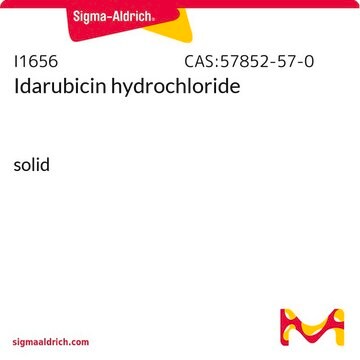M1323
Midostaurin hydrate
≥98% (HPLC), solid, kinase inhibitor
Synonym(s):
CGP 41251, N-[(9S,10R,11R,13R)-2,3,10,11,12,13-Hexahydro-10-methoxy-9-methyl-1-oxo-9,13-epoxy-1H,9H-diindolo[1,2,3-gh:3′,2′,1′-lm]pyrrolo[3,4-j][1,7]benzodiazonin-11-yl]-N-methylbenzamide, N-benzoylstaurosporine, PKC-412
About This Item
Recommended Products
product name
Midostaurin hydrate, ≥98% (HPLC), solid
Assay
≥98% (HPLC)
form
solid
color
off-white
solubility
DMSO: >10 mg/mL
storage temp.
−20°C
SMILES string
O.CO[C@@H]1[C@@H](C[C@H]2O[C@]1(C)[n@@H]3c4ccccc4c5c6CNC(=O)c6c7c8ccccc8[n@H]2c7c35)N(C)C(=O)c9ccccc9
InChI
1S/C35H30N4O4.H2O/c1-35-32(42-3)25(37(2)34(41)19-11-5-4-6-12-19)17-26(43-35)38-23-15-9-7-13-20(23)28-29-22(18-36-33(29)40)27-21-14-8-10-16-24(21)39(35)31(27)30(28)38;/h4-16,25-26,32H,17-18H2,1-3H3,(H,36,40);1H2/t25-,26-,32-,35+;/m1./s1
InChI key
YEKDLUZCCDJYAJ-LJAYRLSQSA-N
Related Categories
Biochem/physiol Actions
Features and Benefits
Signal Word
Danger
Hazard Statements
Precautionary Statements
Hazard Classifications
Repr. 1B
Storage Class Code
6.1C - Combustible acute toxic Cat.3 / toxic compounds or compounds which causing chronic effects
WGK
WGK 2
Flash Point(F)
Not applicable
Flash Point(C)
Not applicable
Personal Protective Equipment
Certificates of Analysis (COA)
Search for Certificates of Analysis (COA) by entering the products Lot/Batch Number. Lot and Batch Numbers can be found on a product’s label following the words ‘Lot’ or ‘Batch’.
Already Own This Product?
Find documentation for the products that you have recently purchased in the Document Library.
Customers Also Viewed
Articles
Protein kinase C (PKC) is an AGC kinase that phosphorylates serine and threonine residues in many target proteins.
Protein kinase C (PKC) is an AGC kinase that phosphorylates serine and threonine residues in many target proteins.
Protein kinase C (PKC) is an AGC kinase that phosphorylates serine and threonine residues in many target proteins.
Protein kinase C (PKC) is an AGC kinase that phosphorylates serine and threonine residues in many target proteins.
Our team of scientists has experience in all areas of research including Life Science, Material Science, Chemical Synthesis, Chromatography, Analytical and many others.
Contact Technical Service













